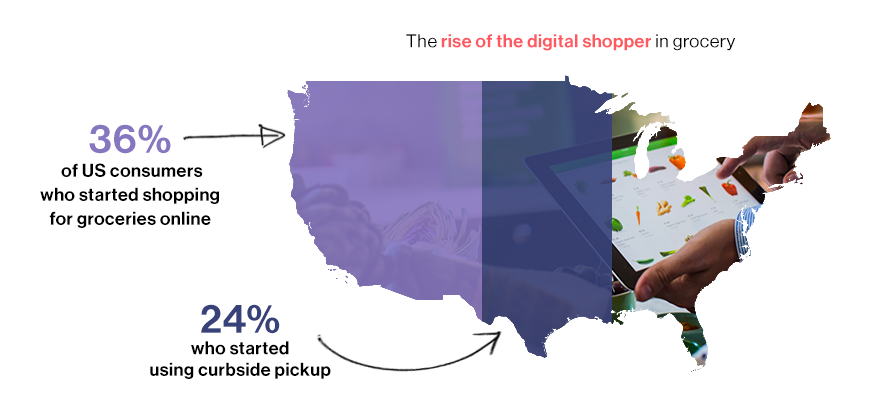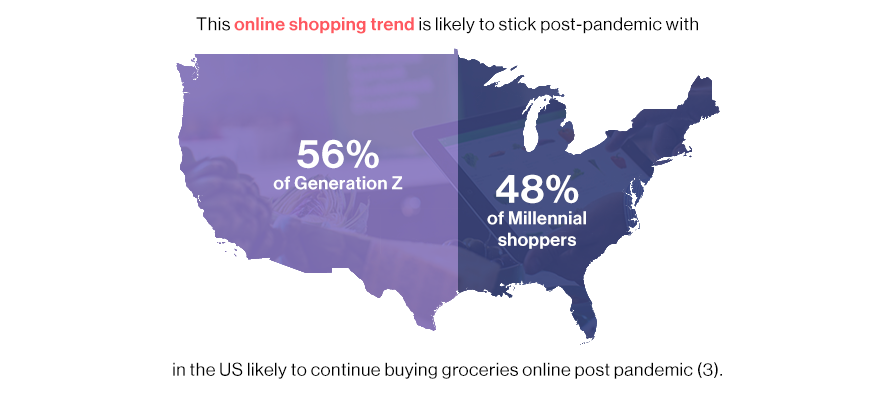2020 coaxed shoppers to adopt online shopping amidst the pandemic. This popularized eCommerce across all demographics and accelerated the shift to online shopping by years. Food & beverage, grocery, and edible CPG goods too saw a massive uptick in online orders and experienced unprecedented online demand during COVID-19. This trend is definitely here to stay and brands and retailers need to jump on this opportunity to convert the newly birthed online shoppers and make an imprint on the eCommerce ecosystem.
The answer lies in harnessing AI driven technology. While 2020 marked the dawn of a new eCommerce era, 2021 will be all about pivoting retail businesses to adapt to the ‘new normal’ and there’s no two ways about it – If 2020 has taught us anything it is that the retailers and brands that overcame the pandemic disruptions were the ones that were flexible and quick to adopt a digitally driven approach, led by technology.
Coping With The Shifting Trends In Food & Grocery Retail
- The rise of the digital shopper in grocery
36% of US consumers who started shopping for groceries online and 24% who started using curbside pickup during the pandemic will continue to do so even after it is over. This predicted behavior shift implies that the rise of the digital shopper is here to stay – and like most digital consumers, they will compare product pricing before making their buy decision. Price competition will be even more intense after COVID subsides than it was prior to the pandemic.

The reality is, the war for the online customers is prominent, but it’s been hidden, in large part, by the fact that grocery sales have increased. When grocery retailers arm their merchandising team with AI tools to augment product assortment decisions, they’ll be able to find incremental gains they couldn’t before. Moreover, these AI tools will be critical in providing the enhanced digital experience that the shoppers now consider paramount to their grocery purchasing experience.
As the slowed economy drives customers to be more selective and price-conscious, retailers who rely heavily on historical data alone to drive assortment decisions are headed for trouble. While this approach was ineffective pre-COVID, now it can be fatal.
- Localization & zip-code level customization
The big shift in food retail is how the local food movement has started to change the assortment landscape. Increasingly more grocery shoppers are returning to their roots, seeking local food, supporting local farmers to reduce the environmental impact of transporting food from long distances. Assortment solutions need to enable local store managers to source, validate and test local products – essentially supporting a curated offer of all that is local – and integrate this with a more efficient central assortment which takes into account the number of customers who will order online and therefore do not need to choose and purchase the product instore. In short, it requires a blend of the data-driven, machine-assisted recommendations and human approach to truly enable grocery retailers to deliver at a local level. For these reasons, the need for zip-code level tracking of price and assortment is paramount for a highly customized assortment. Retailers can no longer have a central assortment strategy for the entire market. They need to track assortment at a local level and devise strategies accordingly. The forward-thinking leaders that get this balance right will enhance customer experience and grow sales, as well as re-establish an influential role for the store manager which has also been lost in centrally run retail operations.
Re-imagining Food & Grocery eCommerce with AI-driven Tech
With the rollercoaster of a pandemic year behind us, grocers are finally getting accustomed to the ‘new normal’ and setting their eyes on winning big in 2021. The pivotal events of 2020 accelerated the shift to grocery eCommerce by years, and now grocers need to work towards building a digitally-quipped, modern and unified business experience for their consumers. And to do so, leveraging AI and data-driven retail-tech solutions is their best bet. Let us look at the key areas where AI will be harnessed in 2021:
- The Need for Real-time Consumer & Competitor Analytics
The online demand for food and grocery that skyrocketed amidst COVID-19 intensified the survival tactics needed to acquire and retain customers. Keeping up with the shopper’s constantly evolving online buying behavior needs requires fast, accurate analysis of demand patterns, shopping history, and buying trends to understand and predict demand. AI driven, intuitive analytics will play a key role in increasing conversions and profitability by analyzing consumer behavior in real-time and drawing data-driven insights that can anticipate demand, drive sales, offer highly personalized promotions, improve consumer experience, and avoid waste.
Another key role that AI analytics will play is to gather competitive intelligence. By analyzing competitor movements on a daily or even hourly basis, retailers can make informed decisions across pricing, promotions and inventory to offer the most competitive deals to their customers and improve visibility of their products.
- Innovation in Supply Chain and Fulfillment
When online demand hit the roof at the onset of COVID-19, grocers scrambled to fulfill the orders, and few succeeded, in the absence of a robust supply chain model. This online shopping trend is likely to stick post-pandemic with 56% of Generation Z and 48% of Millennial shoppers in the US likely to continue buying groceries online post pandemic. Legacy supply chains lack the resilience to quickly adapt to the changing demand or respond to a crisis, as established during COVID-19. These legacy, vertical supply chains are too rigid to meet the changing consumer demand, lack transparency, base their predictions solely on historic data and have proved to be brittle in the times of crisis.

Grocers need to move away from vertical supply chains to supply networks that can manage increased product assortments, speed of fulfillment, and consumption model convenience while continuously iterating processes and improving lead time. They need to broaden their fulfillment options by offering same day free delivery, curb-side pickup and BOPIS options. Collaborating with multiple suppliers and investing in AI-driven, multi enterprise supply networks will be key to forecasting demand and supply to maintain inventory levels, avoiding both food waste and stock outs, anticipating and responding to crisis, and scheduling prompt deliveries to stay on top of consumer demand.
- Competitive Pricing to Cater to the Price-Sensitive Digital Consumer
To cater to today’s highly informed and price sensitive shopper, grocers will need pricing intelligence to offer the best deals without compromising on their product margins. Unlike in a physical store where prices are more or less static for days and even weeks, with online shopping, prices can change rapidly – Amazon uses its dynamic pricing algorithms to review prices of millions of its SKUs including for groceries, every 2 minutes. To thrive in this fast-paced eCommerce environment, AI-driven dynamic and competitive pricing solutions will be the only way to really optimize pricing as humans simply cannot make decisions fast enough across thousands of SKUS.
Further, retailers will leverage AI to deliver winning assortments by identifying the ever changing buying patterns and consumer demographics and offering the right mix of assortments at all times. With AI assortment intelligence, retailers will be able to monitor similar products across their competitor landscape and make smart assortment decisions based on competitive insights.
- Curating Winning Assortments by Analyzing Consumer Buying Patterns
While the pandemic pushed consumers into purchasing food and grocery items online, it also changed their shopping habits – while one segment turned to healthy and whole foods, the other larger segment went for comfort food with good shelf-life. Many eCommerce retailers have cashed in on this trend by pushing relevant advertising towards these segments, keeping the high demand products in stock, and facilitating re-purchases.
Another noticeable trend was that people started shopping for brands and products they were familiar with, in the absence of free sampling available in supermarkets. Retailers quickly pivoted by analyzing consumer data and modifying their assortments by stocking only the high-demand items. Frito-Lay is one brand that cut down 21% of its SKUs to be able to focus more on the production and distribution of its top selling products and ensure their availability everywhere.
While the role of AI is undeniable in product assortment planning, its effectiveness lies in the methodology and the approach used by retailers while deploying AI in assortment planning. In the food retail space, retailers must take into account multiple factors while using AI in optimizing their product assortments and forecasting demand. Some of these include: using predictive search results, visual cues and voice search to enhance digital experience, leveraging relevant historic data to adjust assortments according to seasonal demand patterns, tracking revenue trends across multiple platforms, and timely introduction of new products, SKUs, and new store openings.

AI Tech Investment for A Robust eCommerce Foundation
Striking the perfect balance with your eCommerce business requires data and a strong foundation based on advanced analytics across pricing, inventory, and online visibility.. Specifically, you need to analyze historical data and market intelligence in order to forecast trends, compare and optimize prices, improve product visibility on search engines, and prevent stockouts.
How do you accomplish this? By having a complete historical view of your (and if possible, your competitors’) online catalogs, you can track stock movement, and effectively determine the right replenishment points, the ideal product launch timing, and the best prices and promotions to improve sales and conversions.
Tapping into the market and competitor intel is critical, but equally important is the speed and efficiency of your methods. This is where AI and automation will come in. Automating how you collect and analyze data helps you make smarter pricing, merchandising, and product visibility decisions more efficiently. Grocers need to invest in scalable, automated AI solutions and merchandising analytics with easy, plug-and-play capabilities that can be deployed within days. Moreover, it is critical that the AI solution you choose has good machine learning capabilities in order to capitalize on the huge volumes of data that will be fed into it. A holistic AI tool that tracks the historical data, finds patterns therein and has some level of predictive capabilities is the best bet for retailers in deploying AI to create winning eCommerce businesses.
References:
https://www.emarketer.com/content/online-grocery-sales-will-increase-by-nearly-53-this-year
https://www.forrester.com/report/US+Grocery+Digital+Best+Practices/-/E-RES162937
https://www.washingtonpost.com/road-to-recovery/2020/09/01/grocery-shopping-coronavirus-impact/



















![Diablo 4 Mod Apk Newest Model [Unlimited Excitement]](https://digibytetoday.com/wp-content/uploads/2025/06/1750344127_1-final-180x135.jpg)


















